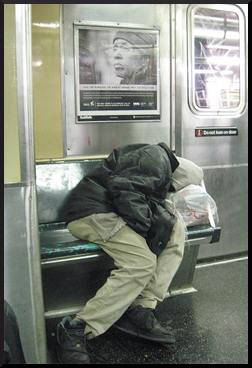
In the fall of 2011, New York City’s “Advantage” program was running out of money because the state quit paying, and the city didn’t want to pay, and a judge said okay, the city didn’t have to. It was predicted that the number of homeless families in New York would double, and that the building of at least 70 more shelters would be imperative. Jennifer Peltz wrote for The Huffington Post:
The four-year-old program was designed to move families out of shelters and into permanent housing. It provides rent subsidies for up to two years to homeless people who have secured jobs but can’t pay the rent from their earnings alone.
Let us repeat that, because it might be the most significant phrase on this page. “[…] homeless people who have secured jobs but can’t pay the rent from their earnings alone.”
It is a point that many of the program’s critics ignored, but a very important point nonetheless. That program came into being not for the benefit of the very troubled, messed up, most recalcitrant, and off-putting segment of the homeless population. No. The program was created for people with jobs. In other words, the working poor; fathers and mothers who were employed and doing their best to support their families, and still not making it.
House the Homeless has laid this out already in many of our pages — which a search for the “Universal Living Wage” will reveal. Briefly, as co-founder Richard R. Troxell recently wrote:
… [T]he federal government sets a national federal minimum wage that affects tens of millions of our poorest citizens, both black and white. Remarkably, the last several U.S. Conference of Mayors Reports point out that this standard is so low that even while working 40 hours in a week, at this wage rate, no one can get into and keep basic rental housing anywhere in this country.
In other words, it is theoretically impossible for just about anyone to live inside of walls beneath a roof. How people manage to do it is a heartbreaking story in itself, of multiple jobs and overcrowding, and a constant shortage of everything.
In February of 2012, the homeless advocates who took it to court lost their case, and the city prepared to cut off rent assistance to around 9,000 of the formerly homeless families who were in the two-year program. Most had known the assistance would end by summertime anyway. That had been a ticking time-bomb all along, something they had to be ready to face. But the early termination would leave everyone even less prepared.
The Associated Press quoted Mary Brosnahan of the Coalition for the Homeless, who mentioned that it would cost the city less to keep the Advantage program going than to finance the existence of the same people in shelters. Of course, nobody listened.
Then, on another front, New York City tackled the problem of single homeless people looking for shelter beds. A policy was suggested whereby the supplicants would have to prove they had no other options. This idea has two outlandish aspects. First, isn’t there something in classical logic about the impossibility of proving a negative? Second, the authorities are making the ridiculous and unbelievable assumption that anyone would choose to stay in a homeless shelter if they had any other option.
Anyway, a judge put a stop to it, but only on procedural grounds, not because the requirement itself would be illegal.
Only a month later, the city’s controversial mayor Michael Bloomberg decided that homeless shelters could no longer accept food that had not been nutritionally assessed. Since New York contains some of the world’s wealthiest people, a lot of what the distribution centers received was rich folks’ food, dropped off by synagogues and churches with long-standing arrangements to donate their surplus leftovers after social events.
But Mayor Bloomberg was concerned that the balance of vitamins and minerals eaten by people experiencing homelessness might not be optimal, and the proportion of fiber in their diets might not be correct, and they might be taking in too much trans fat or too much salt. Therefore, he reasoned, it would be better for them to eat nothing at all. Even Investors.com called the ban “ludicrous” and said:
He would rather see the five boroughs’ downtrodden starve than consume excess cholesterol.
(To be continued…)
Reactions?
Source: “Judge: NYC OK To End Rent Subsidy For Ex-homeless,” The Huffington Post, 09/03/11
Source: “8k formerly homeless NY families to lose rent help,” The Wall Street Journal, 02/03/12
Source: “Court: NYC can’t implement new homeless policy for singles,” USA TODAY, 02/21/12
Source: “New York’s Bloomberg Says Let The Homeless Eat Nothing,” Investors.com, 03/26/12
Image by edkohler.


